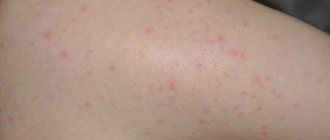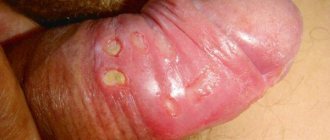The appearance of heat rash in children - a rash on the face and body - can be puzzling and worrying for parents. Miliaria occurs in adults, but infants are especially susceptible to it. From this article you will learn about why prickly heat appears in children, how to treat it, and in what situation you need to contact a pediatrician.
What is prickly heat
Miliaria (heat rash) is a skin disease that often occurs in newborn babies.
The skin of a child under one year old is very sensitive to even the slightest environmental influences and illiterate care, as a result of which redness and rashes may appear on it. In itself, prickly heat in newborns is not dangerous; it cannot be contracted. However, inexperienced parents may mistake the symptoms of dangerous problems (allergies or infections) for signs of prickly heat, because they are often similar. But if prickly heat can be easily treated with home remedies, treatment of infections and allergies requires urgent medical attention.
Complications
Untreated heat rash can lead to:
- infection of rashes;
- development of diaper dermatitis;
- the formation of persistent diaper rash.
Of course, the most dangerous complication is the addition of infection. It is accompanied by a number of symptoms:
- increased body temperature;
- skin itching;
- restlessness and irritation of the child;
- cloudiness of the liquid filling the bubbles;
- rapid opening by a bubble and the formation of flaky areas in their place.
If the usual heat rash can be cured quite easily, then such symptoms are not to be joked about. It is necessary to immediately show the child to the doctor and wait for further recommendations!
Why does it often occur in newborns?
If your baby has heat rash, don’t worry, because you can get rid of it quite quickly if you follow simple rules for caring for your child’s skin. Just try to start treatment as early as possible so that the process does not reach a serious stage.
Usually prickly heat in babies occurs in the summer heat. But, if you are used to wrapping your child in a blanket that is too warm in winter and spring, then it may appear in the cold season. When a baby's sensitive skin is severely irritated, a small red rash appears on it - the main sign of heat rash.
Why is the skin of newborns prone to prickly heat? It's all about unformed sweat glands, which will begin to work in normal thermoregulation mode only by the age of 5-6 years. In addition, children's skin is still very thin and sensitive, it has very powerful blood circulation, and it consists of 85% water (unlike adult skin, which retains only 65% moisture).
The processes of constriction and dilation of blood vessels, which occur quickly in an adult body, are still slowed down in a child’s body - so thermoregulation also occurs very slowly. This is why the newborn’s body overheats and becomes hypothermic instantly.
Treatment of diseases
Each of these diseases requires its own approach to treatment, but the basis of therapy is the elimination of factors that cause skin irritation. In the case of allergies, anti-inflammatory drugs (local, including hormonal) can be an effective remedy, as well as desensitization - a gradual decrease in sensitivity to the allergen. Miliaria usually does not require special treatment, unless it is caused by systemic disorders in the endocrine, nervous or cardiovascular systems.
In order to get rid of the most unpleasant symptoms of the disease, you should use special cosmetics, in particular La-Cri products. They do not contain substances that can cause an allergic reaction, and the main active ingredients in them are extracts of medicinal plants. La-Cri products are excellent for caring for irritated and painful skin in both adults and children.
Causes of heat rash in infants
And yet, even in hot weather, heat rash may not appear in a newborn if the baby’s skin is always breathing. But places where air flows poorly are high-risk areas. Most often, overheating of a baby’s body is caused by too warm clothes or a blanket, as well as tight swaddling: without air access, sweat cannot evaporate in time, and when it accumulates, irritation occurs.
The most common causes of prickly heat:
- keeping the child in a stuffy, hot and humid room;
- Irregular bathing of the child;
- frequent use of fatty cream, especially in hot weather;
- the use of children's clothing not made from natural, but from synthetic materials;
- the child is constantly in a diaper;
- heavy sweating due to increased body temperature;
- dressing the baby in tight and very warm (unsuitable for the weather) clothes;
- wrapping yourself in warm blankets.
The skin of children who were born prematurely, as well as those who are overweight and have diabetes, is more likely to develop rashes because their skin practically does not synthesize the pigment melanin. Normally, it is produced by special cells - melanocytes, “coloring” a person’s hair, skin and eyes a certain color. In addition, melanin has a special function - protecting the body from sunlight. When melanin is not synthesized enough in the skin, it becomes very sensitive to ultraviolet radiation.
Miliaria can also be a concomitant symptom when a baby is sick with acute respiratory infections, measles, tonsillitis, or pneumonia.
Symptoms and types: what does prickly heat look like and how does it manifest in infants?
Miliaria can manifest itself with various symptoms:
- in the form of nodules or bubbles against the background of red skin, which does not merge into a single “picture”; such rashes can most often appear in skin folds - on the neck, groin, armpits; they can cause pain and also be very itchy (this becomes obvious when the baby tries to scratch the redness); similar symptoms may last 1-2 weeks;
- in the form of silver or white bubbles that appear on the neck, torso or face. Bubbles with contents can merge into a single large spot, then they burst, gradually dry out and peel off; such a rash is usually not painful or itchy, and symptoms last no more than three days;
- in the form of flesh-colored bubbles: they may appear several hours later, after the baby has overheated and sweated; bubbles appear on the torso, arms and legs and disappear quite quickly, leaving no traces;
- in the form of complicated forms (white and yellow prickly heat).
How to distinguish miliaria from other types of rash?
Miliaria in children appears in the form of skin redness and rash, but it is often confused with urticaria, diathesis, lichen, dermatitis, measles or allergies. Sometimes it is very difficult to distinguish it from other diseases, even from a photo, so to get an accurate diagnosis it is better to consult a doctor and get tested.
Usually, prickly heat begins with the formation of small pink dots on the skin, and then turns red and increases in size, bubbles with a clear liquid appear inside, and when they burst, the skin begins to peel off, and prickly heat can also be identified by the baby’s constantly weeping skin.
If a child tries to scratch the rash, but following the rules of hygiene does not produce results, then this is a clear signal that the baby has some other disease.
Allergies, chickenpox and prickly heat: how to distinguish?
As already mentioned, the main symptom of prickly heat is a rash and redness of the skin. These manifestations of miliaria may affect only one area of the baby's body (for example, the armpits or groin), or they can spread more widely. If your child is very young, the symptoms of heat rash can be irritating, causing anxiety and disrupting sleep. But since chickenpox, measles and allergies begin with symptoms similar to prickly heat, it is better to show the baby to a pediatrician.
How to understand that a child has heat rash and not another disease? Remember: have you violated the hygiene rules for caring for your baby’s skin over the past few hours? Namely:
- if you have poorly maintained hygienic skin care, miliaria in newborns appears in the neck area;
- if the child overheats and has been wearing clothes made of synthetic fabrics for some time, prickly heat will appear on the back;
- if you often apply a rich cream in the groin area and rarely remove your baby’s diaper, prickly heat will develop in the groin area and buttocks;
- if the rash from prickly heat that appears on the neck is not treated in time, it can spread to the face;
- when the baby is constantly wearing a hat (even at home and on hot days), a rash may appear in the head area.
If you treat the baby’s delicate skin in a timely manner and follow the rules of care, the prickly heat will go away quite quickly. But a rash due to infection or an allergic reaction, on the contrary, will spread progressively.
Treatment of heat rash in infants
In order for the treatment of prickly heat in newborns to quickly give the desired result, you must first get rid of the causes that provoked prickly heat:
- Monitor the air temperature in the room where the child is constantly located; it should not be higher than 22 degrees; at higher temperatures, try to ventilate the room more often;
- do not use synthetic fabrics for your child’s clothes and bedding;
- leave your baby without a diaper more often - especially when he is awake at home;
- do not be afraid to “catch” the child in a warm room, constantly wrapping him in a warm blouse and rompers: at a temperature of 20-22 degrees, a healthy child will not freeze;
- do not use fatty creams and oils - especially for the groin areas, it is better to use powders;
The following will help eliminate the symptoms of heat rash in newborns:
- the use of herbal decoctions of string, chamomile and special mixtures while bathing a child: you can brew herbs according to the instructions, preparing about a liter of decoction in advance and then adding the cooled infusion to a bath of water; you can wipe the areas of the skin where prickly heat occurs with a decoction after taking a bath; A weak solution of potassium permanganate added to the bath has a slightly drying effect;
- After taking a bath, the baby's skin must be thoroughly dried with blotting movements - especially in the armpits and groin areas, as well as on the neck. Areas affected by prickly heat can be treated with a powder containing zinc oxide, starch, talc, anesthesin (for easy cooling) and panthenol (for rapid healing of wounds);
- on the recommendation of a doctor, you can use creamy products Bepanten, Desitin, Drapolen: they will help cope with rashes faster.
- For prickly heat in newborns, folk remedies can also be effective: wiping the affected areas with soda (1 tsp) dissolved in water (1 tbsp.); sprinkling the rash with starch; rubbing with infusion of bay leaves (7 pieces per 1 tbsp. boiling water).
When is urgent pediatrician care needed?
- if, subject to hygiene rules and treatment, the rash does not go away after 3 days;
- if the rash interferes with the child’s normal sleep, causes itching, pain and anxiety;
- if there is serious inflammation and swelling at the site of the rash;
- if ulcers with an unpleasant odor or cracks have formed in the affected areas;
- if the baby has a fever;
- if prickly heat in an infant continues for more than three days, and instead of improvement (drying out of the rash), the opposite process occurs (yellow or white liquid appears inside the blisters, the scale of the rash increases, and the child behaves very restlessly), consult a pediatrician immediately;
- If bloody contents are released from the rash, and the baby begins to vomit, call an ambulance immediately.
Such symptoms may signal an infectious process, and it will be difficult to cope with it without the help of a doctor. Contact your pediatrician: he will either prescribe treatment on his own or refer the child for a consultation with a dermatologist.
How to prevent heat rash in newborns
- Your baby will not develop heat rash even in the hot summer if you always dress your child according to the weather and monitor the temperature in the children's room;
- choose clothes for your baby not based on “beautiful”, but on the quality of “breathable” materials;
- dress your child in loose clothing;
- change your baby’s diapers regularly and often leave him naked to “ventilate”;
- bathe your baby daily;
- do not swaddle your baby too tightly;
- use powders and baby creams exclusively on a water basis;
wash children's clothes with special hypoallergenic products.
Use of folk remedies
At home, prickly heat in children can be easily treated with folk remedies: herbal decoctions, bathing in water with potassium permanganate, using powder, soda compresses. Here are some recipes for such procedures:
- Talcum powder or baby powder. Apply powder to the baby's irritated skin every time you change diapers. It is better to first lubricate areas affected by prickly heat with baby cream or milk (in the summer, quickly absorbing water-based lotions are suitable). First, apply the talc to your hand, and then gently spread it onto your child's skin where the rash is.
- Decoctions of herbs (chain, chamomile, calendula). To prepare the product, you need to calculate the required amount of herb, depending on the volume of the bath (3 tablespoons per 10 liters of water). Add it to boiling water and boil for another 15 minutes. Then we leave the herbal decoction to infuse under the lid for another 45 minutes and add it to the baby’s bathtub.
- Potassium permanganate. You need to fill a glass with water boiled in a kettle, into which you previously (without touching with your hands) poured potassium permanganate crystals. Wait until the boiling water dissolves them completely and stir the potassium permanganate with a teaspoon. The color of the solution should be purple, and in no case black. It is important that all crystals dissolve, otherwise they will cause a burn if they come into contact with the child’s skin. Pour the resulting solution into the bath and bathe the child.










